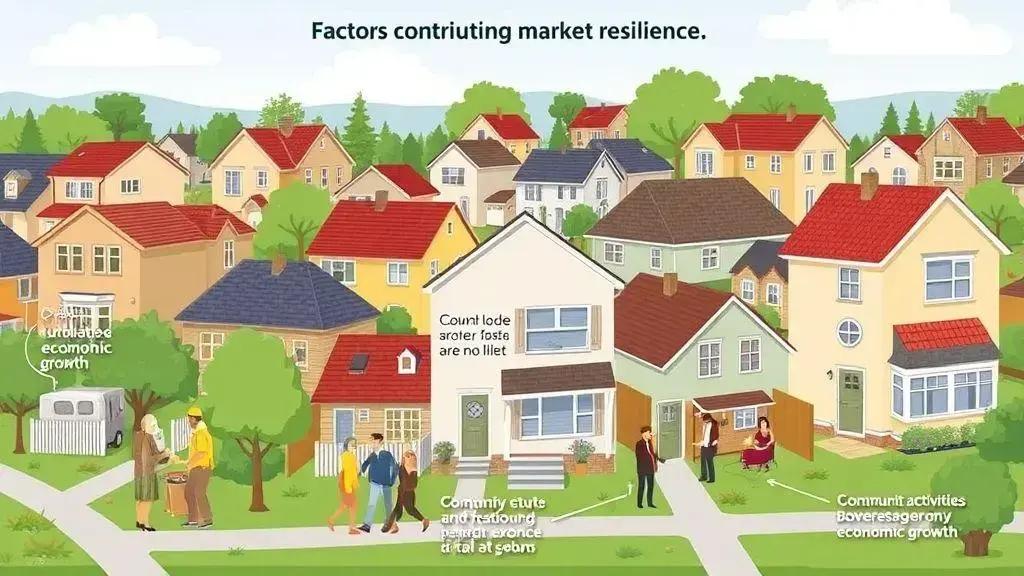Real estate market resilience in inflation cycle

The real estate market resilience in inflation cycles is driven by factors such as economic diversity, demographic trends, and effective investment strategies, allowing properties to maintain value during economic fluctuations.
Real estate market resilience in inflation cycle is an intriguing topic, especially as economic challenges arise. Have you ever wondered how property values hold steady even when prices soar? This article dives into the relationship between inflation and the stability of real estate investments.
Understanding the impact of inflation on real estate
Understanding how inflation affects the real estate market is crucial for investors and homeowners alike. Inflation can lead to increased costs for materials, labor, and services, which directly impacts property values and rental prices.
How Inflation Influences Property Prices
When inflation rises, construction costs typically increase. This means that new homes often come with a higher price tag. Additionally, existing homeowners may hesitate to sell due to the fear of not finding affordable replacements. As demand for housing remains high, prices can level out or even rise in inflationary periods.
- Supply and demand: As inflation rises, the demand for housing often increases.
- Cost of materials: Higher costs lead to increased prices for new constructions.
- Rent prices: Landlords may raise rents to keep pace with inflation.
The investment flows into real estate can vary during periods of inflation. While some may see it as a hedge against inflation, others might shy away due to perceived risks. Real estate is often viewed as a stable asset, offering appreciation potential even when the economy faces turmoil.
Historical Context of Inflation and Real Estate
Historically, certain periods of heightened inflation have not significantly reduced the appeal of real estate. For instance, during the late 1970s, many investors found that real estate outperformed other investments. Even in turbulent economic times, properties tend to retain their value and provide a reliable income through rent, making them attractive options for safeguarding against inflation.
Not only do property values generally rise during inflation, but strong rental markets can emerge as people seek affordable housing alternatives due to increased mortgage rates. This creates opportunities for investors to generate steady rental income.
Ultimately, reflecting on the impact of inflation is essential for understanding the real estate market. By doing so, investors can make informed decisions, anticipate trends, and leverage opportunities.
Factors contributing to market resilience

Several factors contribute to the resilience of the real estate market, making it a reliable investment even in uncertain economic times. Understanding these factors can help investors make informed decisions and adapt to changing conditions.
Economic Fundamentals
The underlying economic conditions greatly influence market resilience. A strong job market typically leads to higher demand for housing, as more people can afford to buy or rent. This demand can help stabilize property values even when inflation is on the rise. Interest rates also play a crucial role; lower rates make borrowing cheaper, encouraging more buyers to enter the market.
- Consumer confidence: When people feel secure about their financial future, they are more likely to invest in real estate.
- Local economic growth: Areas with growing industries tend to attract new residents and businesses, bolstering the housing market.
- Government policies: Incentives such as tax breaks for homebuyers can stimulate demand.
Another essential factor is the diversity of the housing market. Regions with a mix of property types—single-family homes, apartments, and commercial spaces—can better absorb shocks from economic fluctuations. This diversity helps maintain stability, as different housing segments react differently to market changes.
Demographic Trends
Shifting demographics also play a significant role in market resilience. Younger generations, such as millennials, are entering the housing market, often seeking urban living and affordable homes. Their preferences influence new constructions and renovations, helping to keep the market dynamic.
Furthermore, as populations grow, the demand for housing remains steady or increases. This ongoing need keeps property investments valuable, creating opportunities for both homeowners and investors.
Understanding these factors can empower potential buyers and investors. By analyzing economic fundamentals, recognizing demographic trends, and monitoring local market diversity, you can better navigate and benefit from the real estate landscape.
Investment strategies during inflationary periods
Investment strategies during inflationary periods require careful consideration to ensure that your assets maintain value. During inflation, investing wisely can safeguard your wealth and even help it grow. Understanding these strategies is vital for potential investors.
Diversifying Your Portfolio
Diversification is a key strategy. By spreading your investments across various asset classes, you can reduce risk during economic fluctuations. This strategy includes not just stocks and bonds, but also real estate, commodities, and other alternatives. Each of these asset classes may respond differently to inflationary trends.
- Real estate: Properties often appreciate in value during inflation, making them a solid investment.
- Commodities: Investing in gold or silver can be a safe haven, as they typically retain value.
- Stocks: Look for companies that have strong pricing power to maintain profits.
In addition to diversification, understanding market cycles is critical. Inflation usually leads to rising interest rates, which can affect your investments differently. Real estate, for instance, may initially face high mortgage rates, but long-term property appreciation can outpace these challenges.
Utilizing Inflation-Linked Securities
Another effective strategy is to invest in inflation-linked securities, such as Treasury Inflation-Protected Securities (TIPS). These securities adjust with inflation, ensuring that your investment appreciates over time. Investing in these can provide a safety net against rising prices.
Moreover, consider focusing on growth-oriented sectors, like technology or renewable energy. These areas may thrive even when inflation rises and can present vast opportunities. Keeping an eye on trends and adapting your investments accordingly will enhance your strategy.
By implementing these investment strategies, you can navigate inflationary periods with greater confidence. Staying informed and flexible is key to protecting and growing your investments during times of economic uncertainty.
Case studies of resilient real estate markets

Case studies of resilient real estate markets reveal valuable insights into how certain locations withstand economic challenges. Observing these markets helps investors understand what contributes to lasting property value. Let’s explore some key examples.
Urban Areas with Diverse Economies
Cities like Austin and Seattle have demonstrated remarkable resilience. Their economic diversity, with strong tech, healthcare, and educational sectors, attracts residents and businesses alike. This creates a stable demand for housing, even during economic downturns. In these cities, the real estate market continues to thrive due to local job growth and population influx.
- Job opportunities: A mix of industries ensures stability.
- Population trends: Growth in younger demographics boosts housing demand.
- Quality of life: Amenities and education systems enhance market attractiveness.
Another noteworthy case is Miami, which has shown remarkable persistence despite economic fluctuations. Its appeal as a cultural and financial hub draws international buyers, sustaining property values. The real estate market here benefits from its vital tourism sector and ongoing infrastructure development, which reinforce its economic foundation.
Suburban Resilience
Suburban areas like Frisco, Texas, also illustrate how markets can remain robust. With appealing family-oriented communities and access to good schools, these suburbs attract buyers looking for affordable options outside major cities. In periods of high inflation, these areas often see strong demand as families search for more space and affordable living conditions.
Investors should consider these case studies when assessing market resilience. By analyzing factors like economic diversity, job growth, and demographics, one can better predict how different regions may perform during economic ups and downs. Understanding these dynamics provides insights into long-term investment potential.
FAQ – Frequently Asked Questions about Real Estate Market Resilience
What factors contribute to the resilience of the real estate market?
Key factors include economic diversity, job growth, and demographic trends that support ongoing demand for housing.
How can I protect my investments during inflation?
Diversifying your portfolio and considering inflation-linked securities can help safeguard your investments from inflation’s impact.
What are some effective investment strategies during inflationary periods?
Investing in real estate, commodities, and growth-oriented sectors can provide good returns despite inflation.
Why are case studies of resilient markets important?
They offer valuable insights into how different regions maintain property values during economic downturns, guiding future investment decisions.





